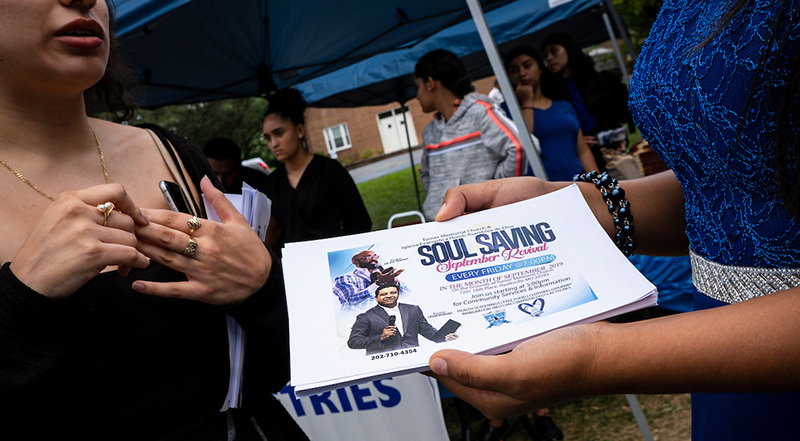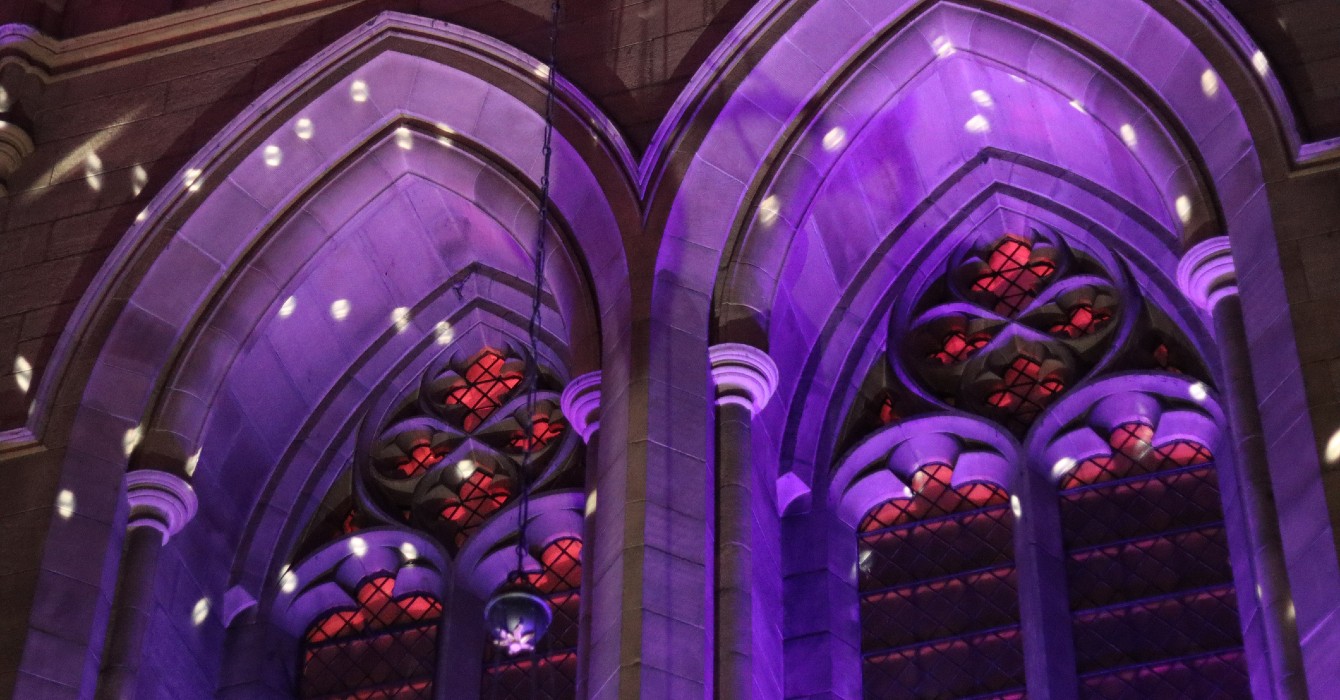On a bright Sunday morning in September, the congregation of Turner Memorial AME Church gathers at its Hyattsville, Maryland, building. A pastor is delivering an impassioned message. Applause crackles through the space as worshippers lift their hands under the sanctuary’s vaulted ceiling.
But the person speaking from the pulpit is not the Rev. Dr. D.K. Kearney, Turner Memorial’s pastor since 2015. The preacher is the Rev. Cesar Moreno, a minister originally from Guatemala, who is sharing the day’s word -- in Spanish.

For nearly two years, the pastors’ churches -- one an African Methodist Episcopal (AME) congregation more than a century old, one a largely Latino nondenominational congregation established in 2010 -- have been sharing the Turner Memorial building.
It’s more than just a transactional arrangement. Church members have worked carefully and intentionally to build the relationship between the two congregations, which includes regular shared services and, this fall, the “Soul Saving September Revival,” a four-week joint endeavor.
It involves the close friendship of the two pastors, as well as the efforts of 16-year-old interpreter Josary Moreno Mejia (a preacher in her own right and the granddaughter of Cesar Moreno).

“In Christ, there is no Jew or Gentile. There is no race or color,” Kearney says later that Sunday from the pulpit, after Moreno’s message concludes.
The Turner Memorial pastor looks out on the congregation, which includes members of Iglesia Evangelica Horeb Asamblea de Dios (Mt. Horeb for short) -- the church pastored by Moreno and his wife, first lady Loly Moreno.
“We cannot allow the world’s culture of division to separate us. We cannot allow the enemy who comes to steal, kill and destroy to separate us,” Kearney continues, getting louder. “We are one in Christ Jesus.”
It is this focus on unity that exemplifies Turner Memorial’s activities, efforts deeply rooted in the church’s traditions -- including, for example, its long-standing relationship with a local synagogue. Kearney is now working to unify the Turner Memorial and Mt. Horeb congregations under one roof, as together they reach out to the surrounding community.
This work is important to both pastors.

“As followers of Christ, we are to follow Christ’s example. And the example which he laid out during his ministry here on earth centered, in my opinion, around community, and building community, and living in community,” Kearney said. “As a church, that which represents Christ, we are to serve our community with the hope [that] by serving the community we win persons over to the family of God.”
Moreno agreed. “Speaking spiritually, people need salvation. People need to be on a better path. This is the objective, to teach people the path of God, … so that new generations can have hope and live better,” he said.
A ‘God-ordained’ relationship
When Kearney became pastor of Turner Memorial in 2015, he was working on his doctorate of ministry with a focus on liberation theology at Payne Theological Seminary. He found, through his research, that the church’s surrounding community was in large part Latino.
He wanted to reach those community members and began considering different ways the church might connect beyond its walls. He also began leading the church in a series of workshops focused on deploying spiritual gifts to make an impact.
Time passed -- Kearney calls it a period of “preparation” -- and in 2017, Moreno and his granddaughter began attending Turner Memorial services while seeking a space for Mt. Horeb.
When the two pastors met, they realized they could create opportunities for their congregations -- one English-speaking, one generally Spanish-speaking -- to worship together. They began partnering in December 2017.
Are you open to opportunities that might come your way?
The two developed a friendship that Moreno’s granddaughter Mejia describes as “a brotherhood.”
“They both have said and shared that when one comes to preach to the other’s church, they speak and help lift the other’s spirit,” she said.
Kearney elaborated: “It never fails that every time when we are together, even when we are meeting, I cannot help but to feel the presence of God. … It gives me the confirmation that what is happening is God-ordained.”
Today, Mt. Horeb holds its own services in the Turner Memorial building. But on the second Sunday morning of each month, its members join Turner Memorial’s. There, Moreno preaches in Spanish while his granddaughter interprets.
And on the fourth Sunday evening of each month, Turner Memorial members go to Mt. Horeb’s service, where Kearney delivers a message that Mejia translates into Spanish.

For Kearney, the combined worship reflects a core value of intentionally building relationships. Turner Memorial also has a partnership with the historic Washington, D.C., synagogue Sixth & I -- located in the building that housed Turner Memorial for 50 years before the congregation moved to Hyattsville.
Kearney and Senior Rabbi Shira Stutman speak at each other’s place of worship each year during the weekend of the Martin Luther King Jr. holiday.
“[Kearney] is amazingly generous with the pulpit God has assigned him to,” said the Rev. Dr. Natasha Jamison Gadson, Turner Memorial’s minister of leadership growth and development.
As long as Kearney senses that speakers have the Holy Spirit and that they are focused on the same goal of serving God, she said, “he is open with the pulpit for other pastors to come and share.”
Being open to others -- interacting with diverse communities -- provides an opportunity “to learn something we don’t know about God, our neighbors and the Christian life at large,” said Ismael Ruiz-Millán, the director of the Hispanic House of Studies, Global Education & Intercultural Formation at Duke Divinity School. He also directs programs within the divinity school for non-Hispanic clergy and laity who want to serve the U.S. Latino population.
In what ways could your congregation expand its notion of Christian life, and act upon it?
“If we really believe that all human beings are made after God’s image but we insist in keeping ourselves in circles with people who are just like us, then we really have an incomplete notion of who God is and what the Christian life is about,” Ruiz-Millán said.
The community commitment
In general, both community and church members have responded to this outreach. For instance, on the Sunday before the first Friday revival in September, representatives from the two churches handed out more than 7,500 flyers to share information about the coming events.

“I think it is such a great experience,” said Joan Goodluck, a Turner Memorial member originally from Guyana who identifies as black. “I am seeing God’s work being revealed, because he wants the nations of the world to come together.”
Now 78, Goodluck grew up in a Christian home and attended church with majority-black congregations for much of her life. She said that hearing the word in both Spanish and English has been a learning experience for some worshippers, adding that the preaching of the word “helps me to grow more.”
Mejia, who devotes her time to ministry while taking high school and college classes as part of her high school’s dual enrollment program, is a big part of this growth.
She regularly interprets for services at both churches -- including translating from Spanish to English at Mt. Horeb for young people who don’t speak Spanish.
In this way, she provides clear messages to congregants and community members even as the pastors speed their cadences and raise their voices.
Are there ways in which you serve others that you could reframe as ministry?
“I thank God overall, because it’s a blessing,” Mejia said after one Sunday morning service at Turner Memorial.
She asks God to speak through her lips when she preaches as an individual and when she interprets for the pastors, she said.

During the service, Kearney noted that Mejia does a “wonderful job” (a message she humbly interpreted).
And as Mejia stood outside the sanctuary afterward, people hugged her, with one woman telling her, “You are such a blessing.”
Others too have positive thoughts about the churches’ union.
“I think it’s something really good -- good because God calls us to be one body in Christ,” said Evelyn Chávez, a Mt. Horeb member.
“We share the gospel, first. But we are not only sharing the gospel. … There are people with needs. They need clothes; they need many things,” Chávez said.
A new kind of innovation
A pillar of the young partnership between these churches is the September revival series. In past years, Turner Memorial has held revivals featuring pastors from outside the community. But when planning this year’s activities, Kearney said he felt he needed to go out to the people instead of waiting for them to come into the church.
He committed to having the two churches gather outdoors along with neighbors from the community. Members of both churches worked together to plan events.
On the first Friday in September, rows of colorful chairs were lined up outside the building, under a large white tent.
A band that included a singer, a keyboardist and a drummer played lively Christian music with Spanish lyrics as children toddled around in the grass and older attendees wearing everything from T-shirts and jeans to dress shirts and pants wandered among various outdoor booths.
At one booth, stacks of clothing ready to be given away were so plentiful that the church halted donations for the revival’s second week. One booth offered voter registration; another, immigration information.
Reaching out together with Mt. Horeb, and having activities in both English and Spanish, including those offering community aid, may be an innovation on the traditional revival.

“When I look at tradition and the church, what we are doing is traditional,” he said. “Because on the day of Pentecost, when the Holy Spirit fell, Scripture says that everyone heard the gospel being preached in their native language. And that day 3,000 souls were saved.”
In what ways could you innovate on tradition in your context?
But people can allow personal preferences about language, race and social class to separate them from others, Kearney said.
“And I would dare to say, don’t confuse one’s preference with tradition. Because traditional church teaches us that all of God’s children -- regardless of language, race, class -- gather together. And that when the Holy Spirit falls, everybody hears the good news,” he said. “If this is innovative, it is traditionally innovative.”
Light in the darkness
On the first night of the revival, attendees gathered under the tent as the service began, reading song lyrics from copied pages so they could worship together.
“Promise keeper, light in the darkness. My God, that is who you are,” they sang before switching to Spanish. “Cumples promesas, luz en tinieblas. Mi Dios, así eres tú.”
Have you worshipped or sung in other languages? If not, what might you learn from that experience?
“We have come to let the enemy know that no race, no language barriers will stop us. We are not trying to build walls, but we are building bridges,” said Kearney, standing at the front of the tent, as Mejia interpreted.
Moreno then delivered a message in Spanish, telling those gathered that Jesus is the saver of their souls. At one point, his voice and his granddaughter’s overlapped, the English and Spanish floating together, as the worshippers clapped their hands in response and the keyboardist played on.
After the sky went from pastel to dark, Moreno’s message ended, and people came to the altar to receive prayer. As the prayer teams and respondents gathered, one woman stood with them, crying as she raised her hands.
When the altar call ended, Kearney addressed the crowd, declining to do a benediction, he said, because he wanted the revival’s spirit to continue. He urged attendees to bring their friends and families to the next event.

“Thank you all so much for coming out,” he said, with Mejia repeating his words in Spanish. “Bless you.”
The crowd lingered, talking and embracing one another, as light continued to shine from the revival tent on the warm September night.
Questions to consider
Questions to consider
- When the two pastors met, they recognized that they had a unique opportunity to build something together. Are you open to opportunities that might come your way?
- Ruiz-Millán said that if Christians engage only with people like themselves, they have “an incomplete notion of who God is and what the Christian life is about.” In what ways could your congregation expand its notion of Christian life, and act upon it?
- Mejia said that when she interprets for others, she experiences God speaking through her. Are there ways in which you serve others that you could reframe as ministry?
- Kearney calls this partnership “traditionally innovative.” In what ways could you innovate on tradition in your context?
- Have you worshipped or sung in other languages? If not, what might you learn from that experience?


















